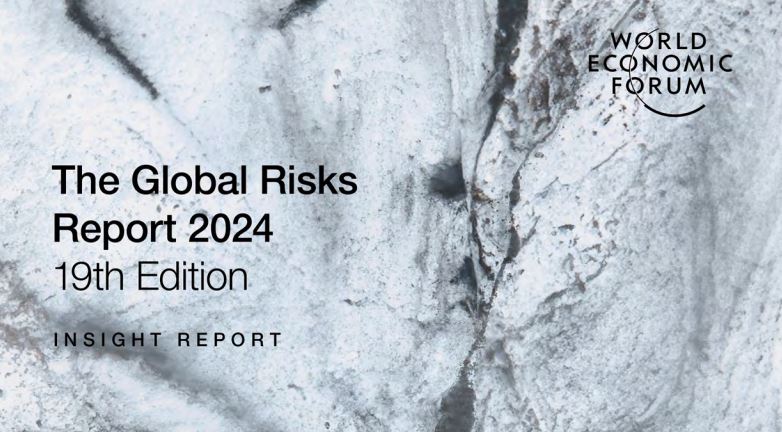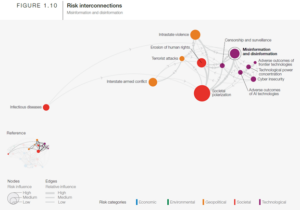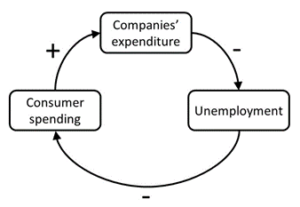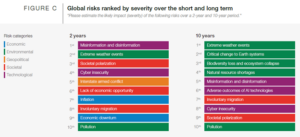Are we doing any better? Some thoughts on the World Economic Forum’s 2024 Global Risks Report
An exchange between the Cascade Institute’s Michael Lawrence and Thomas Homer-Dixon.
ML: Last week, the World Economic Forum (WEF) released the 19th edition of its annual Global Risks Report based on its risk perception survey of nearly 1500 experts in academia, government, international organization, business, and civil society (I’ve provided a short summary of the report in the Polycrisis Resource Library).
One of the most notable features of this year’s report is the complete absence of the term “polycrisis,” which figured prominently in the WEF’s 2023 edition. I speculate that the authors made the omission because so much of the reaction to last year’s report focused solely on the merits of this neologism; these debates were often unproductive and overshadowed the actual findings and insights of the report. Instead, the preface of this year’s report speaks merely of “a duo of dangerous crises: climate and conflict” (p. 4). And the related concept of “systemic risk” is also notably absent (the term “catastrophic risk” appears four times—still rather sparse for such a long document on global risk).
These omissions notwithstanding, the 2024 Report does show some advances in its systems thinking that resonate with the Cascade Institute’s theorization of global polycrisis. We focus on systemic crises, which occur when a shock pushes a global system from an established equilibrium into a volatile disequilibrium that inflicts significant human harms. Systemic crises arise when long-term systemic stresses erode an equilibrium so that a trigger event—even a stochastic event or something that would earlier have had little effect—can push the system into disequilibrium. The 2024 Global Risks Report analyzes four such system stresses (climate change, demographic bifurcation, geostrategic shifts, and technological acceleration) by introducing the term “structural forces.” And it asserts that “Weakened systems only require the smallest shock to edge past the tipping point of resilience” (p. 14).
A systemic crisis ends when the system either returns to its old equilibrium or finds a new one marked by a different set of structures, behaviors, and characteristics. “Just as natural ecosystems can be pushed to the limit and become something fundamentally new, such systemic shifts are also taking place across other spheres: geostrategic, demographic and technological… Across [these] spheres… we are transitioning to a new underlying set of conditions and parameters” (WEF 2024, pp. 4, 40). But today these systems remain in the tumultuous interregnum between stable equilibria, and that is a key feature of the global polycrisis.
The 2024 Global Risks Report also pays much greater attention to climate tipping elements—subsystems of the Earth system that, stressed by climate warming, may “flip” to a new state in a virtually irreversible transition that alters the overall behavior of the climate (for example, the Amazon rainforest could soon flip from carbon sink to carbon source). “Critical change to Earth systems (climate tipping points)” is a new entry to the list of 34 global risks assessed in the Report. And this year’s Risk Interaction Maps add causal directionality to what were previously treated as merely correlational relationships between global risks. The addition allows us to explore causal feedbacks among risks, a crucial consideration that was aptly highlighted in the 2011 Global Risks Report but largely absent from the intervening editions.
For example, here is a segment of the risk interconnections map highlighting risks related to misinformation and disinformation:
Despite these advances, the 2024 report makes the rookie systems thinking mistake of understanding positive versus negative feedbacks as a normative distinction (between good and bad feedbacks) rather than an empirical one (between reinforcing and balancing feedbacks—the correct formulation): “As struggling companies cut costs, unemployment may rise, reducing consumer spending and creating a negative feedback loop that can contribute to a deeper economic downturn” (p. 31). Though the described feedback is highly undesirable, it is actually a positive—self-reinforcing—one:
(As companies’ expenditure decreases, unemployment increases; as unemployment increases, consumer spending decreases; and as consumer spending decreases, companies’ expenditure decreases even further).
Students struggling to understand causal loop diagrams can take some solace in how common it is to make this sort of mistake.
These instances of systemic thinking (excluding the last one) in the 2024 report are an improvement over past editions. But the more significant questions are: does this report give us anything fundamentally new? And does it give us an accurate, useful picture of the current global risk landscape? I will leave these questions to Tad (spoiler: no, and no) and simply mention a few notable changes in the risk rankings (which are rated in one-, two-, and ten- year timeframes) in the 2024 versus 2023 report (see diagrams below for 2024 rankings):
- ‘Interstate armed conflict’ is a new entrant to the two-year top ten list, reflecting a growing awareness of the sharp reversal in the decades-long decline of war globally (notably, the WEF’s risk perception survey concluded before Hamas’ October 7 attack and Israel’s ensuing invasion).
- ‘Adverse outcomes of AI technologies’ is also a new entrant perceived to become more severe over time (i.e., in the ten-year timeframe).
- ‘Inflation’ and ‘Economic downturn’ are new entrants to the two-year top ten rankings, though survey respondents tend to treat these risks as transitory, so they do not appear on the ten-year list.
- ‘Misinformation and disinformation’ and ‘Societal polarization’ rank higher than in the past, probably because 3 billion people around the world are eligible to vote this year and next, and many of those elections will be contentious, divisive, and plagued with false information.
Based as they are on opinions assessed in the WEF’s Global Risk Perceptions Survey, these rankings naturally vary somewhat year to year according to the most pressing concerns of the moment. But the editors of the newly released book The Era of Global Risk rightly observe that over the course of 19 Global Risk Reports there has been “a long-term move away from concern about external threats we need to secure ourselves against (such as specific viruses or terrorism) and towards systemic risks that we, as human beings, are creating for ourselves, through poor governance, short-termism, and a too narrow focus on economic productivity” (Beard et al., 2023: xii). This is at least one form of progress.
THD: There are many holes in this analysis from a quick scan. Three notable egs.:
- The question that motivates Figure B seems to presume unicausality.
- Interstate armed conflict ranks as 5 in the short term, but is entirely absent from the 10-year assessment. Yet nearly two-thirds of the respondents think that the world situation will be either “catastrophic” or marked by “upheavals” in ten years—uhhh, and those situations won’t lead to war as a major consequence?
- Absence of food crisis in the list, despite the fact that in 10 years, three of the top four risks are environmental. It’s not even in the causal “interconnection” maps. This is a huge lacuna, and we should highlight it in the intro to the food report—OK?
- Also, the absence of a call out to geographical choke-points is notable. Maybe they highlight this factor outside of the diagrams.
Very interesting that they say this: “Weakened systems only require the smallest shock to edge past the tipping point of resilience” (p. 14). We’ve surfaced this intuition, of course, and made it a central point in our analysis.





